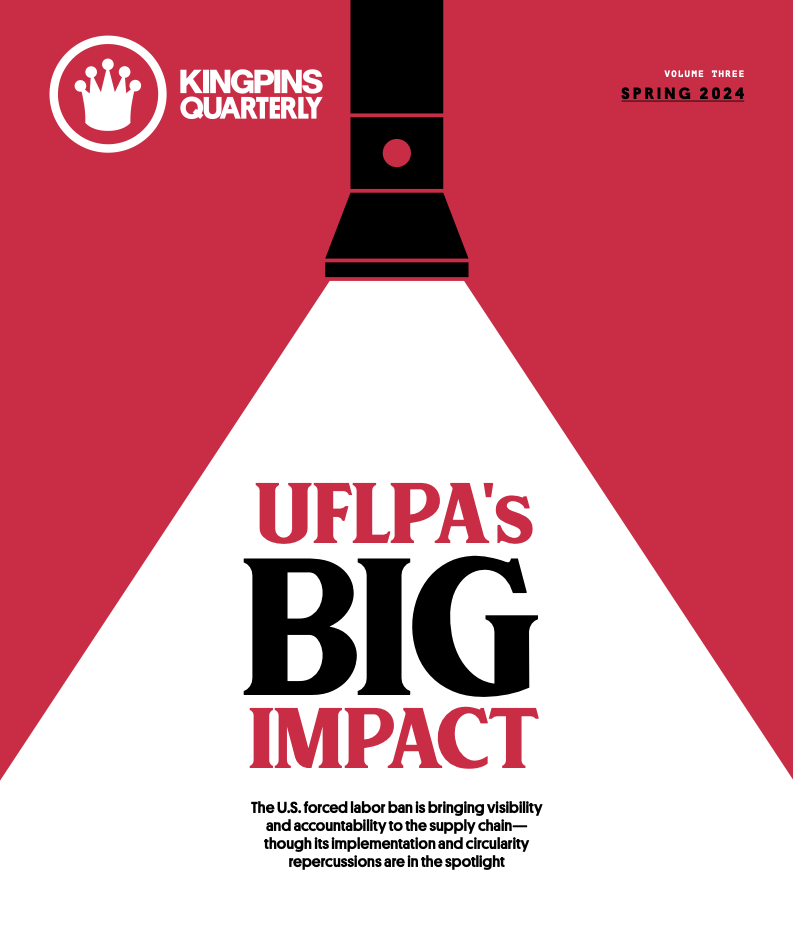The clock is ticking on the climate crisis and already the apparel industry, as a whole, is failing to keep pace toward its 2030 goals. It’s the worst time for inflation to deliver sluggish revenues and razor thin margins, but that’s the scenario facing denim today. Despite rising costs of goods and weak sales, the industry is sticking to its commitments, developing new innovations designed to create less impactful processes and products. But this progress comes at a cost—one that requires both upstream and downstream players to invest in a transformation that will only hasten once the new sustainability legislation cropping up on both sides of the Atlantic goes into effect. It’s a challenging moment but one that denim has no choice but to meet head on.
“We haven’t taken the foot off the accelerator,” stated Jimmy Summers, vice president of environment, health, safety, & sustainability and CSO for U.S.-based Elevate Textiles, owner of apparel businesses that include A&E thread company and Cone Denim. And he’s seeing a similar bullish approach from the company’s supply chain partners. “Everyone recognizes that this [economic environment] is temporary. It’s the exact wrong time to pull back.”
While Elevate is moving forward unabated in reaching its science based targets and continued water and GHG emissions progress, inflation has already stymied some capital projects. “The reality is that for solar projects and other renewable projects and certificates, there’s a cost, and there’s some signals that pricing pressure won’t allow that right now,” Summers stated.
Those market signals mean Elevate will ease up on the gas in those areas. And it’s having a knock-on effect as the company plans for fiscal year 2024, which starts in January. “Even if [the economy] turns around in three to six months, that could change some of the hesitancy to move forward but budgets will be set,” he said.
Matteo Capellini, associate partner in consulting firm Bain & Company’s ESG and retail practice, reported that from fast fashion to luxury, the leading players are becoming even more ambitious, especially where decarbonization is concerned.
“Maybe in the initial moment of the inflation crisis, projects were put a little bit more on hold. But generally speaking, I would say that maybe for the big players, the journey actually increased its speed, especially in light of the new legislation coming in,” he said.
Sharing the load
Increased speed requires bigger investments but the industry is already grappling with how to share the costs inherent in massive transformation.
For Summers, it comes down to collaboration and communication.
“I hear a lot about decoupling growth from sustainability. Right now, GHG targets are coupled with price pressure—that creates a tension. We’re committed to being part of your scope 3 reduction plan and pathway because we’re going there too but we need assurance that we’ll be in partnership and share the costs,” Summers said. “Ultimately, we’re competing with folks that aren’t [working toward those targets].”
Those are the types of conversations Summers would like to see more of. It’s the reason Elevate is an active member of organizations like Textile Exchange, ZDHC and SAC. “We’ve made an intentional effort and spent a lot money on those memberships so we can all together craft the best approach so we don’t waste time on approaches that don’t work in the supply chain,” he said.
According to Miguel Sanchez, technology leader for the Kingpins denim trade show and Transformers Foundation board member, too often upstream partners are expected to absorb the costs for sustainability changes.
“These costs are borne 100 percent by the suppliers because otherwise they cannot work” he said. It’s an additional expense for mills that are already carrying the inventory burden on behalf of their brand partners, Sanchez said. And many, due to greatly reduced order sizes, are operating their facilities at break even or worse. “The pressure is from all sides. If you want the business, you have to [provide] a wonderful product at a very low price, and at the same time, you need to meet all the requirements from the government and then also meet the pressure from NGOs.”
This so-called “perfect storm” isn’t stopping the mills from innovating though. On the contrary, Sanchez said these companies are constantly developing new products and processes but financing these advancements is always the challenge. “When you go to promote something to the brand, they are interested in sustainability but it must be cost neutral. [The message is,] ‘You need to absorb all the investment, absorb all the promotion, all this analytical work, all the tests,’ which is not very encouraging,” he said.
In some cases, Sanchez said, the burden is lessened thanks to government subsidies, though that typically only applies in countries for which apparel production is their bread and butter.
Aurangzeb Shafi, executive director of Pakistan’s Crescent Bahuman vertical denim facility which supplies major brands in the U.S. and EU, acknowledges there’s a range of relationships in the industry—some more collaborative than others. “There are certain customers who just give you the targets on a piece of paper, and they say, ‘We don’t care how you achieve them.’ That’s an issue. But thankfully, enough of the brands that we work with, we find them very engaging and cooperative,” he said.
Often, he said, who funds what depends on the type of initiative. For investments related to anything considered table stakes, like water reduction or cotton traceability, mills are expected to absorb those costs. “They see that as part of being a sustainable business. For groundbreaking technologies, we do see a premium,” Shafi said, pointing to Crescent’s Blue Infinity, a technology that allows for indigo-free dyeing, as an example of the latter.
Shafi credits inflation with prompting Crescent to investigate innovating the dyeing process. “Situations like inflation have forced companies like us to start questioning things which perhaps we haven’t questioned before,” he said, adding ultimately sustainability is good for business. It’s a mindset his downstream partners share, he said, which is why many have doubled down on their environmental commitments over the last 18 months. “It’s just a continuous process, and you just have to be more and more creative.”
Tony Tonnaer, owner of KOI, a conscious consulting firm, and founder of the sustainable denim brand Kings of Indigo, acknowledges that making the best choices for the plant comes at a cost and layering on inflation makes it a challenging environment. But, he said, it can be done. “Ten, maybe 20 years ago, it was 30 percent more expensive to produce sustainable garments. Now, you can do it for 10 percent more. So, you have to pay that 10 percent, and you have to look somewhere else to get those costs back,” he said. “You have to think smarter—smarter in your purchasing, in how to source, in how to develop product differently.”
Leaning into legislation
Tonnaer is looking to governmental regulations to help accelerate the pace of these changes. “We need legislation to make companies move otherwise it would be too slow,” he said. “The most important thing is that all the world should work together on trying to get legislation as close as possible to each other. We need similar benchmarks, similar legislation so we can all work towards a similar goal.”
Here, incentives like tax breaks or lower duties would go a long way, Tonnaer stated.
Ultimately, Tonnaer said the last few years have been an inflection point. “COVID and economically interesting times or politically interesting times are always a good feeding button for change. I hope we can use this to think differently about our business models,” he said, noting he’s already seeing companies making smaller collections and sticking to more core products, which he thinks is a positive. “One of the biggest problems we have is the warehouses have too much clothing, and all of the outlets do amazing business. But it’s not healthy for our industry. It’s much more damaging than inflation because that’s where you lose money in fashion.”
From his perspective, Capellini thinks the new laws will help companies operationalize sustainability by ingraining it into every department. “What will happen is that the purchasing department will discuss the quantity, the quality, the price, and the emission factor with suppliers,” he said, as an example. “This is exactly what happened with digital 20 years ago or more, when it was first just the IT manager, and now digital is clearly embedded in all functions.”
Capellini also sees the new legislation finally giving CSOs some teeth, which hasn’t been the case in many companies. “[Today,] the CSO don’t have actual power of making things happen,” he said, adding that that’s been a major barrier to transformation. “From a reporting perspective, the CSO is going to see their role empowered and more relevant. It will influence the CFO domain a lot due to the necessary reporting.”
Summers sees the slate of sustainability regulations as a double edge sword. “Unfortunately, legislation is such a blunt instrument that doesn’t recognize the nuances. They don’t have the [industry] knowledge, and we don’t always do a good job of engaging with policy writers, so you end up with unintended consequences,” he said.
Despite this, he hopes that by setting a minimum sustainability performance, these laws will put everyone on an even playing field, thereby alleviating the extra burden on those companies that have been attempting to do the right thing—and it’s coming just in time. “The low hanging fruit that were out there that were quick wins that save money or are cheaper, those are gone,” he said. “The further we get, the steeper the climb.”




